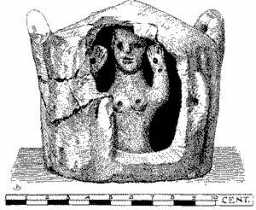
I have a cow shrine in honor of my mom in her room-- her former room. The suite. It's full of cow things she owned, but not all of them because they don't all fit.
About a month after her death, while I was falling asleep, I suddenly envisioned her in my mind's eye, smiling and shining. Her hair was its natural red color as it had been years ago, not the solid white I had gotten used to seeing before she died. It felt like more than my usual vivid imagination. She did not try to communicate anything, and it only lasted a few seconds, but I felt like I was seeing her, really her, in death. And that upset me, because I had been sure I had set everything up right for her to have a quick and easy passage to her next life (because she had often said religion was stupid, and she didn't believe in an afterlife or any gods, so I figured she'd be upset if she had to hang around in an afterlife being wrong for very long.) So of course I reached inside for Sigyn and Hel, and they reassured me: yes, that was really her, and yes, she has already passed on. She was not at that time still hanging on waiting for her desired oblivion. The dead experience time like the gods do, not like living people do. Even though it only took her a few days after her death to pass completely through Hel and on to what was next, she could still look in on me a month later, to make sure I was going to be OK. And what she saw was me curled up with my sweet kitty Happy. So, that was the most OK I could possibly be. Now I was glad I saw her, and that she saw me. It didn't mean she was stuck trying to pass over, it was just a brief visit out of time.
Later that month, I received her ashes. I placed them on the cow altar, along with pictures of her, one of the silver candles from the Death and Butterfly ritual, and the bottle of Patron with which to toast Hel and Hidden Goddess perfume to bless with in Hel's name. The photo above depicts that ritual. I told each of the three items where they belonged: the ashes in the butterfly urn were in their permanent home and would stay with me, the ashes in the rose urn were in their permanent home and would go to my brother, and the ashes in the box would be scattered. I made sure there were neither any lingering soul pieces in what I'd received, nor any bad energy. I had to mentally take the lavender broom to the pain and sweep it into the black hole in space. I double checked the energy in the ashes and their containers later and they seemed to have a normal amount of presence, that is, mom wasn't in there-- she had gone on already-- but it wasn't the kind of empty that would drawn things to a vacuum. During the ritual, I toasted to Hel, and to Audhumla and the cow spirit, and to my mom, and I said that I knew that mom had already gone to where she was going next but I already knew that time did not work the same way for gods and the dead as it did for me, so if mom wanted to tell me anything this was the time to do that. She spoke. She told me she had seen her next life before she went to it and she was happy. That reassurance was a relief. It was not only a relief knowing that she already knew she was going to be happy in her next life because while she was in Hel's realm she could see ahead in time, it was also a relief to know she didn't have any other messages for me.
I left her Shrine of the Great Cow Mother up and made occasional toasts. I knew that eventually I would take it down so someone else could move into the suite, so it was not made to be permanent, but it was operating longer than any other altar I had put up in the house before. Usually when I did holiday rituals I took the altar down the same day, or perhaps the next day. I kept the portable working altar that was just big enough for ritual tools and a bottle in my room, but I kept it covered. This one was still powered, and one morning I went in to open the blinds and curtains for the house plants and felt dark energy in that room. I flicked it away at once, and felt carefully to be sure there was no bad energy on any of the ashes or anything else on the altar. There was not. It didn't come from the ashes or the altar, it was attracted to it from outside. I then performed another ritual, this time focused on the gnome (the land wight of my land) and on Audhumla. I asked the gnome to reinforce his protections against vampiric entities looking for power to eat, and I asked Audhumla to bless her altar and keep bad influences away from it. After that, the power of the shrine didn't draw anything in that wanted it as a snack.
...





















